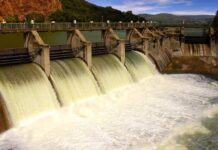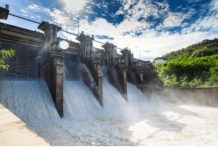SHIZUOKA – Chubu Electric Power Co. said Thursday it has finished building a huge sea wall at its Hamaoka nuclear power plant in Shizuoka Prefecture to protect the facility from a possible earthquake-triggered tsunami.
The construction of the sea wall, which stands 22 meters above sea level and is 1.6 kilometers in length, began in November 2011 — eight months after a huge earthquake and tsunami triggered a triple meltdown at Tokyo Electric Power Co.’s Fukushima No. 1 nuclear power plant.
Located on the Pacific coast, the Hamaoka complex is believed to be situated at what would be the epicenter of a potential massive earthquake in the Nankai Trough, which runs south of Honshu.
The sea wall was built higher than the originally planned 18 meters as the government estimated that tsunami waves as high as 19 meters could strike the nuclear power plant.
In the case of a magnitude-9.0 earthquake originating off Suruga Bay or the Sea of Enshu, which stretches along the Shizuoka Prefecture coast, the city of Omaezaki, where the Hamaoka plant is situated, could be hit by a quake registering 7, the maximum on the Japanese seismic intensity scale, the Shizuoka Prefectural Government said.
Tsunami waves as high as 19 meters would be expected to hit the coast 20 minutes after the quake, it said.
“We have strived to enhance safety in accordance with our belief that there is no option to abandon nuclear power,” Tatsuya Muramatsu, chief of Chubu Electric’s Hamaoka regional office, said after confirming construction had finished on the sea wall.
“With this (wall), we have completed efforts to built anti-quake measures for now,” he added.
The Hamaoka plant suspended operations in May 2011 due to safety concerns at the request of then-Prime Minister Naoto Kan.
Chubu Electric wants to restart the No. 3 and No. 4 reactors at the plant. The reactors are under examination to see whether they meet new safety requirements introduced after the Fukushima nuclear crisis.
The utility has spent around ¥400 billion ($3.56 billion) to enhance safety measures at the plant.











































